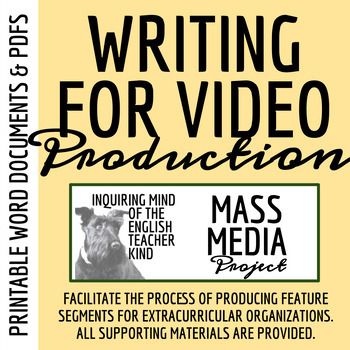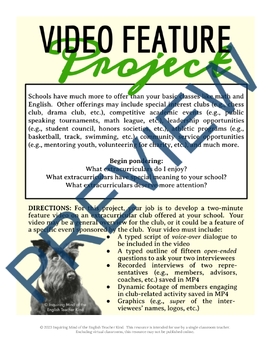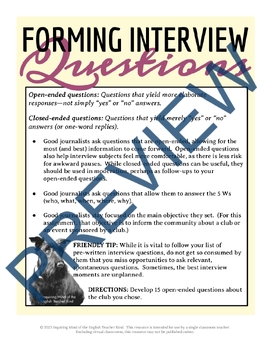Preparing and Writing for a Video Broadcast (Journalism, Mass Media)
Inquiring Mind of the English Teacher Kind
1.2k Followers
Grade Levels
8th - 12th
Subjects
Resource Type
Standards
CCSSW.9-10.2
CCSSW.9-10.2a
CCSSW.9-10.2b
CCSSW.9-10.2c
CCSSW.9-10.2d
Formats Included
- Zip
Pages
10 pages
Inquiring Mind of the English Teacher Kind
1.2k Followers
Description
This media project complements broadcast journalism courses or feature writing units. The primary objective is for teenage students to produce feature segments on extracurricular offerings at their schools, which may then be used by the school for promotional purposes. This project reinforces the conventions of interviewing skills, organization of details using the inverted pyramid technique, and foundations of broadcast writing.
Included are the following:
- A project description.
- Brainstorming materials designed to maximize student learning about their chosen club (functionally speaking, a KWL).
- A document on which students jot down open-ended questions to ask an interviewee, plus a reflective piece to ensure students have written quality questions.
- A prewriting document designed to help students discern vital information from lesser information, aligned to the inverted pyramid concept.
- An exemplar script modeling the conventions of writing for broadcast, plus instructions for how to write for broadcast.
- A rubric for evaluating student work.
Materials are delivered in Word Document and PDF formats. (Alternatively, a Google Drive option is available.)
Total Pages
10 pages
Answer Key
Rubric only
Teaching Duration
3 Weeks
Report this resource to TPT
Reported resources will be reviewed by our team. Report this resource to let us know if this resource violates TPT’s content guidelines.
Standards
to see state-specific standards (only available in the US).
CCSSW.9-10.2
Write informative/explanatory texts to examine and convey complex ideas, concepts, and information clearly and accurately through the effective selection, organization, and analysis of content.
CCSSW.9-10.2a
Introduce a topic; organize complex ideas, concepts, and information to make important connections and distinctions; include formatting (e.g., headings), graphics (e.g., figures, tables), and multimedia when useful to aiding comprehension.
CCSSW.9-10.2b
Develop the topic with well-chosen, relevant, and sufficient facts, extended definitions, concrete details, quotations, or other information and examples appropriate to the audience’s knowledge of the topic.
CCSSW.9-10.2c
Use appropriate and varied transitions to link the major sections of the text, create cohesion, and clarify the relationships among complex ideas and concepts.
CCSSW.9-10.2d
Use precise language and domain-specific vocabulary to manage the complexity of the topic.





